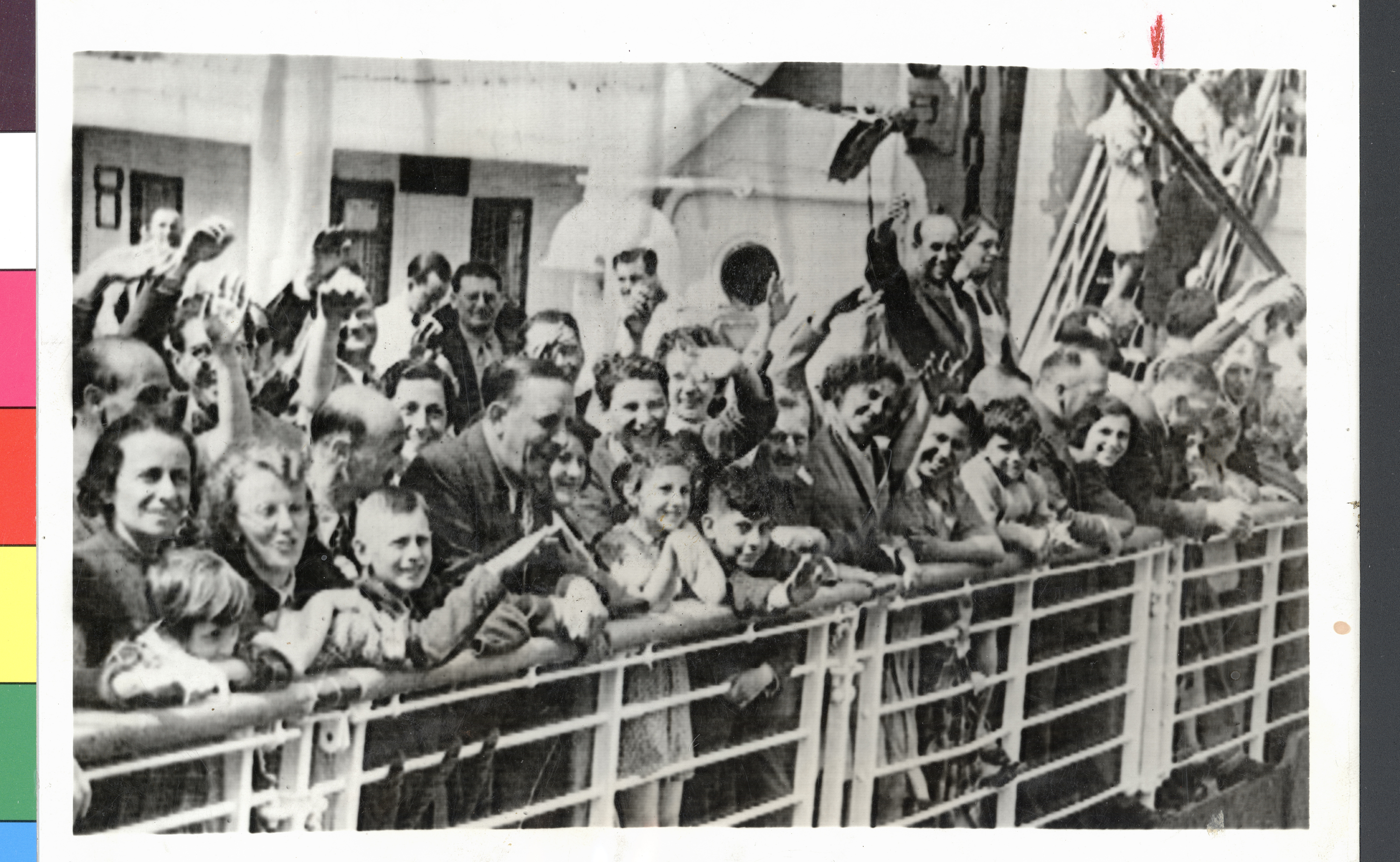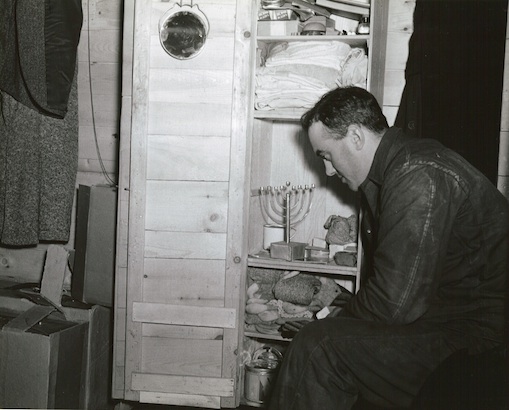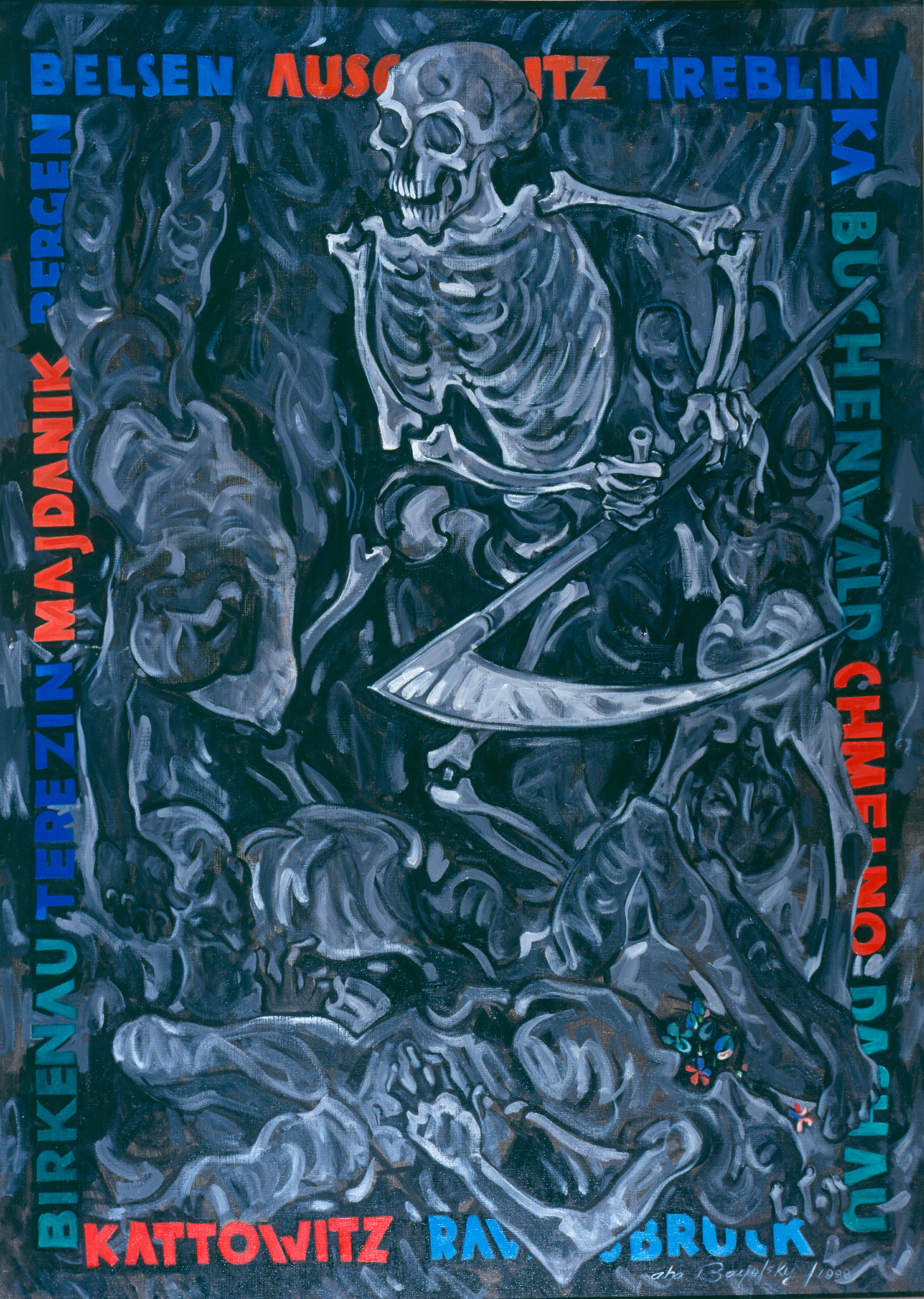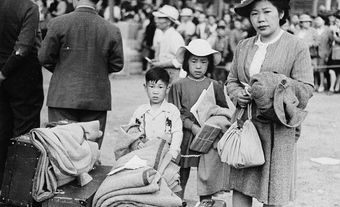The Holocaust is defined as the systematic persecution and murder of 6 million Jews and 5 million non-Jews, including Roma and Sinti, Poles, political opponents, LGBTQ people and Soviet prisoners of war (POWs), by Nazi Germany from 1933 to 1945. Jews were the only group targeted for complete destruction. Nazi racial ideology considered them subhuman. Though Jewish Canadians did not experience the Holocaust directly, the majority endured anti-Semitism in Canada. Jewish Canadians were only one generation removed from lands under German occupation from 1933 to 1945. They maintained close ties to Jewish relatives in those lands. These ties affected the community’s response to the Holocaust. There was, for instance, a disproportionate representation of Jews in the Canadian armed forces. Jewish Canadians were also heavily involved in postwar relief efforts for displaced persons and Holocaust survivors in Europe.

Anti-Semitism in Canada
Prejudice towards people of the Jewish faith, or anti-Semitism, was a socially acceptable part of mainstream Canadian society for many years. It was a form of open and blatant racism that predated Confederation; before the community had a significant presence in what became Canada.
In the years before the Second World War, Jews faced limits on enrollment in educational institutions. Their participation in various fields, such as medicine and law, was also restricted. They were not allowed access to some property and vacation sites. Signs that read “Gentiles Only” and “No Jews or Dogs Allowed” were posted well into the 1930s and 1940s. During this time, discriminatory immigration policies denied sponsorship requests to nearly all Jewish applicants. Canadians overwhelmingly supported government policy that classified Jews as foreigners who could not assimilate. They were seen as posing potential threats to the health of the nation.
Jews were especially vulnerable in Quebec. Roman Catholic priest Lionel Groulx, the “father of French Canadian nationalism,” espoused racist and anti-refugee rhetoric. He did so from the pulpit, on the radio, and in such journals as L’Action Nationale and Le Goglu. Journalist and Nazi sympathizer Adrien Arcand founded the anti-communist and anti-Jewish Parti National Social Chrétien (Christian National Socialist Party). Arcand later led the National Unity Party of Canada. It was an offshoot of anti-Semitic fascist groups that were organized in many towns and cities across the country. These included “swastika clubs” organized in Ontario.
During the Great Depression in Alberta, the governing Social Credit Party spread anti-Semitic beliefs through radio broadcasts and racist literature. Chief among these was The Protocols of the Elders of Zion. It was a fabricated text first published in Russia in 1905. It claimed to outline a plan for Jewish world domination.
On 16 August 1933, a rare incident of Nazi-inspired anti-Semitic violence occurred during a baseball game at Toronto’s Christie Pits Park. Fighting began after members of a local pro-Nazi youth group unveiled a flag bearing a swastika. This provoked an angry response from the opposing Jewish club and fans. Although no fatalities occurred, the “Christie Pits Riot” was a warning for most Jewish Canadians. They felt that they were only one step removed from the tyranny many had escaped, and to which a growing number of their friends and family were once again being exposed to overseas.
Refuge Denied
Threatened by the rise of Nazism, hundreds of thousands of European Jews sought refuge abroad, including in Canada. However, anti-Semitism was common among senior members of William Lyon Mackenzie King’s Liberal government; it informed political decisions regarding the growing refugee crisis. For example, Frederick Blair, director of the Immigration Branch of the Department of Mines and Resources, was blatantly anti-Semitic. Yet Mackenzie King heeded his advice on matters of immigration and refugees.
At the time, Canadian immigration regulations listed Jews among the “least desirable” groups, regardless of nationality. Canada’s longstanding immigration quota system was based on race and was discriminatory. It targeted not only Jews but also Chinese, Sikhs and Blacks. Extra qualifications, such as agricultural skills or proof of $15,000 in investment capital, further limited eligibility for Jewish applicants.
Two events prefigured Canada’s shameful record during the Holocaust: the country’s approach to the Evian Conference; and its role in the MS St. Louis affair.

Evian Conference
The Evian Conference (6 to 15 July 1938) was convened by US President Franklin D. Roosevelt. It was a gathering of world leaders to discuss the growing crisis of German and Austrian Jewish refugees from Nazism. Mackenzie King did not want Canada to attend. He feared that Canadian participation might be seen as a willingness to accept Jewish refugees. He believed that letting in more Jews might “creat[e] a new problem here” and lead to an “intermixture of foreign strains of blood” that would tarnish Canadian society.
Mackenzie King gave in to US and British pressure. He reluctantly agreed to send Canadian delegates to the Evian Conference. But they only went with the reassurance that no country would be forced into action. In the end, the Dominican Republic was the only Evian country to offer Jews asylum.

The St. Louis Affair
In 1939, 907 Jewish refugees fled Nazi Germany aboard the MS St. Louis. On 7 June 1939, they were denied entry to Canada. They had also been refused entry to Cuba, numerous Latin American countries and the United States.
Prominent Canadian citizens asked the federal government to provide sanctuary for the refugees. But the matter was disposed of quickly. Frederick Blair refused to consider the request on the basis of policy. “No country,” he publicly declared, could “open its doors wide enough to take in the hundreds of thousands of Jewish people who want to leave Europe: the line must be drawn somewhere.” The St. Louis was forced to return to Europe; 254 of its passengers were murdered in the Holocaust.
Only 5,000 Jewish refugees were permitted to enter Canada from 1933 to 1947. This was the poorest admission record among Western countries.
Outbreak of the Second World War
Throughout the 1930s, there were roughly 170,000 Jews in Canada. They responded to the rise of Nazi Germany with collective vigour. Jewish newspapers published scathing editorials; they condemned the devastating impact of Nazi race laws on German, Austrian and Czechoslovakian Jews. The Canadian government’s lack of action in challenging those oppressive laws was also targeted. Winnipeg Jews spearheaded boycotts against Germany. Jews across the country joined anti-Nazi rallies. They also lobbied Parliament to allow sponsorship of relatives living under fascist regimes. Women’s groups and landsmanshaftn (mutual aid societies) mounted campaigns to deliver money, food and resources to family and friends in Europe. The Jewish Immigrant Aid Society, charged with immigrant resettlement, helped with sponsorship applications.
Canada joined Great Britain’s fight against Nazi Germany on 10 September 1939. Many Canadian Jews were children of European immigrant parents with ties to family and friends overseas; they quickly signed up for military service. Approximately 17,000 Jews — roughly one-fifth of the country’s Jewish male population — enlisted in the Canadian armed forces. This figure was disproportionately higher than any other minority ethnic group. Of those who served, 421 Canadian Jewish personnel died in service; 1,971 received military awards.

“Enemy Aliens”
After Adolf Hitler’s election in 1933, Great Britain had admitted tens of thousands of mostly German and Austrian Jewish refugees. However, following the start of the Second World War, Great Britain declared them and all persons from Axis countries “enemy aliens.” Britain asked Canada and Australia to accept this group of foreign nationals for the duration of the war. The Mackenzie King government reluctantly agreed.
In the summer of 1940, more than 3,000 refugees were sent to Canada. Among them were 2,300 German and Austrian Jews aged 16 to 60. They were interned in guarded camps in Ontario, Quebec and New Brunswick. The Jews in the group came to be known as “accidental immigrants.” They were initially interned in prisoner of war (POW) camps with actual POWs. This situation was protested loudly by the internees, the Canadian Jewish Congress and the Canadian National Committee on Refugees and Victims of Persecution, an agency comprised of prominent non-Jewish Canadians. The Jewish internees did not pose a threat to national security. They were not safe living among Nazi POWs. Senior Canadian officials realized this and separate camps were established. Nevertheless, the Jewish internees’ legal status remained uncertain. Their POW status was lifted. It was replaced with that of “refugees of Nazi oppression.” Despite this, their legal status in Canada remained ill-defined for many years.
Many of the internees continued their secular or religious studies in the camps. With support from rabbis in Toronto and Montreal, interned rabbis organized camp-wide services for holy days. They also observed the Sabbath and laws of kashrut (Jewish dietary law and custom).
The camps were closed in 1943. The Jewish internees were given the option of staying in Canada or returning to England. Walter Kohn (Nobel Prize in Chemistry), Fred Kaufman (judge in the Quebec Court of Appeal), and Emil Fackenheim (philosopher) were among the 972 who remained in Canada.
Reporting Atrocity
Press reports from the 1936 Olympic Summer Games in Berlin, Germany, provided many non-Jewish Canadians with their first glimpse of Nazism. Reports of Adolf Hitler and his totalitarian regime continued throughout the Second World War. The Canadian government and major media outlets sent journalists, photographers and filmmakers to document military advances. (See Documenting the Second World War.) Major newspapers reported on wartime atrocities in Europe. But mention of Jewish victims was minimal.
In 1943, the Canadian government launched its official war art program to document and report on wartime atrocities. (See War Artists.) Thirty-one artists, including Alex Colville and Aba Bayefsky, were chosen for the program. They created visual depictions of the war (photographs, sketches, paintings) for military records and for viewing by the Canadian public.
Reporters and artists struggled to describe what they witnessed, including human remains at concentration and death camps. Such unprecedented accounts of mass, state-sponsored, anti-Jewish violence challenged comprehension. Few Canadians could begin to fathom the extent to which Nazi Germany had decimated European Jewry.

First Encounters with the Holocaust
In the final months of the Second World War, First Canadian Army forces played key roles in the liberation of Nazi camps in the Netherlands, Belgium and Germany. These had been used to transport Jews to death camps in occupied Poland. Military personnel chanced upon Jews who emerged from their hiding spaces. In December 1944, Toronto-born Jewish chaplain Samuel Cass and his soldiers threw a bittersweet Chanukah party for the few Jewish orphans remaining in Antwerp, Belgium.
For Canadian military personnel, the starkest encounter with the Holocaust and its survivors took place at the Bergen-Belsen concentration camp. It was liberated by the British Army on 15 April 1945. Canadian military units were at the camp within 48 hours. They helped to feed and provide medical attention and translation services for the skeletal survivors, the majority of whom were Jews. Canadian Jewish airmen and soldiers, many of whom spoke Yiddish, gave informal aid to the survivors. Soldiers collected and gave out food, clothing and surgical supplies from military stock with their superiors’ silent approval. In total, more than 1,000 Canadians were at Bergen-Belsen, either through formal service or informal visits.
Evidence of the gross inhumanity that had earned Bergen-Belsen the title “Horror Camp” was everywhere: rampant starvation; typhus and tuberculosis; the crematoria; and piles of unburied corpses. According to historian Mark Celinscak, the suffering that Canadian military personnel and volunteers saw at Bergen-Belsen “became their defining moment of the Second World War… for some it was an awful recurring memory, while for others it altered the course of their lives.”

Legacy: Holocaust Survivors in Canada
Despite awareness of the horrors faced by Jews in the Holocaust, anti-Semitism persisted in Canada well after the war. In 1945, when discussing how many Jewish refugees should be allowed to enter Canada, a Canadian government bureaucrat gave the now-infamous reply, “none is too many.” In a 1946 Canadian public opinion poll, 49 per cent opposed Jewish immigration. Jews were the least desirable immigrant group. Only German nationals ranked higher, albeit not former members of the Nazi Party.
The shift in public opinion, and government policy, towards Jewish immigration was a response to the largest refugee crisis in modern history. It also met a practical demand for skilled cheap labour to support Canada’s postwar economy. The gradual liberalization of policy began with Order-in-Council P.C. 2071 on 28 May 1946; it culminated with the amended immigration policy announced on 1 May 1947. These measures marked a sea change in Canada’s law and popular opinion toward immigrants and refugees. These changes were especially meaningful for Canadian Jews. They were now allowed to sponsor European Jewish refugees through “close relatives” and “labour” schemes. Between 1947 and 1955, the Canadian Jews sponsored and resettled approximately 35,000 Holocaust survivors and their dependents.
Holocaust survivors and their descendants have contributed to all aspects of Canadian society. In spite of this, Canada was the last country in the Western world to erect a national Holocaust memorial monument. On 20 January 2011, the Canadian Jewish Congress and Citizenship and Immigration Canada jointly unveiled The Wheel of Conscience. The monument commemorates the MS St. Louis refugees. It features the passengers’ names and the words hatred, xenophobia, racism and anti-Semitism. It is currently housed at the Canadian Museum of Immigration at Pier 21 in Halifax. The National Holocaust Monument was unveiled in Ottawa on 27 September 2017. Entitled Landscape of Loss, Memory and Survival, it recognizes the Holocaust and its Jewish survivors’ contributions to Canada.
See also: Judaism; Jewish Music and Musicians; Jewish Writing; Passover in Canada.

 Share on Facebook
Share on Facebook Share on X
Share on X Share by Email
Share by Email Share on Google Classroom
Share on Google Classroom


